It all started in 1997.
The world wide web was six years old (previous methods of communication via the internet had been around long before, and young Matt Dale had spent many excited hours watching Wargames and wondering how he could score with an Ally Sheedy type by hacking the Pentagon with his Commodore C64). It hadn’t reached a level of ubiquity across households yet, and Matt’s mum had spent a couple of years abusing her work printer to bring home hardcopies of a Babylon 5 fan-site for him to enjoy.

In September 1997, Matt went to college (note for our US readers – ‘college’ to us Brits isn’t something that involves leaving home and living on campus – that’s University). At his college he gained access to computers every lunchtime that connected to this marvellous beast that was the world wide web, and immediately got to work coding, by hand, a simple website dedicated to Doctor Who, which would be hosted on a free service by Angelfire.
Matt had recently struck up a friendship with the equally nerdy Kevin West. Despite the fact that neither of them could connect to the internet at home, they were determined that the newly named The Millennium Effect would become the de facto source of research for fellow fans. Despite the fact that neither of them had seen The Time Monster, they were determined that The Millennium Effect would become the de facto source of research for fellow fans*.
Matt continued to code at lunch hours, and Kevin on his home PC (taking floppy discs to a local internet cafe that was run out of a council building), and on 26th February 1998, the site launched to the public, with friend Gwyndaf Evans designing a unique logo for them.
*for clarification, they have now seen every episode. Even The Time Monster.
The Millennium Effect was named by Matt after a line from the rough cut of the recent 1996 TV Movie, in which the news-reader referred to various strange goings-on (the ability to walk through windows and such) as being ‘The Millennium Effect’.
Kevin helped explain this by putting together a funky remix of the theme to greet people to the site (it was common in the 1990s to play hideous music and display bright headache-inducting animations to visitors), using the relevant soundbite, along with one from The Chase in which the Doctor describes the Mechanoid city as ‘fantastic!’.


In the next few years the site grew, and although the two went off to separate Universities in September 1999 to study in fields they would later make no use of whatsoever, they continued to work on content. The site moved between free services hosted by Angelfire, Crosswinds, uk2 and eventually Geocities, and along the way picked up its own domain at millennium-effect.co.uk. One of these providers noticed that the site had grown to around 50mb in size (which was a lot back then) and kicked the boys off the server without so much as a by-your-leave. Or any kind of warning, really.
But we’re getting ahead of ourselves…
A major overhaul from the purple-on-black beginnings took place in January 2001…

The new look brought a brighter shade of blue complementing the 1996 TV Movie logo which now adorned the site; from the editors perspective in 2001, Doctor Who ended for good on December 31st 1999 with planet-pulling-inside-out-schenanigans, and it was extremely safe and future-proof to pop a huge picture of Paul McGann in the banner.
A fun plugin randomly generated a pair of Doctor eyes looking at the reader from the menu bar, and content continued to grow.

In March 2002 the domain name changed to drop the dash in the middle. Matt, who had coined the name in the first place, believed that losing the hyphen would make it easier for people to know the URL – neglecting to realise that so few people know how to spell ‘millennium’ properly anyway.
By this point the audio section had grown to cover stories, tribute records, sound effects, soundtracks and stock/pop/classical tracks. The video section had been repeatedly rebuilt in different formats but ultimately was attempting to catalogue all the oddities in Matt’s collection – TV appearances, rough cuts, raw effects footage and so on – along with a few unusual articles. A range of articles entitled ‘Change My Dear’ documented the differences between a number of episodes rough cuts and their broadcast edits – this drew the attention of TME to the BBC’s ‘Restoration Team’, who used the website to prepare the deleted scenes package on Vengeance on Varos. The articles are long since lost now, but we fondly remember how they were created – by linking two VHS machines up to a single TV on two channels, synchronising videos on both of them, and then toggling between the channels twice a second until they went out of sync. Amazingly the TV in question didn’t blow any electrics.
In November 2003, celebrating the show’s 40th anniversary, a new look site was launched, returning the lighter purple colours from v1 (the grab below is sadly missing most of the images that gave the site its specific look, which was mostly based around the PostAntiqua font associated with the TV Movie). At this point one of the thoroughly researched sections from v2, a guide to all the commercial VHSs around the world, with release information, covers and dates that certifications were issued in the UK and Australia, was retired in favour of a growing guide to the DVDs, story by story, which was intended to start bringing in the information from the original VHS guide as secondary information within each DVD page. Unfortunately a hard drive crash saw the loss of the original VHS guide, and rebuilding the original research proved extremely off-putting – ironically then, the lack of VHS data caused the DVD guide to falter.
Alongside the new launch, the team also finally released their charity album Return to Kendal.

This new look was headed up by an animated banner that Matt hand-animated during an all-night session (amazingly, he even managed to find himself a girlfriend at this point in his life; it didn’t last long). It was based on a video version of the Windows XP desktop image, tinted purple.

TME was periodically updated over the next few years. With Richard E Grant announced in 2004 as the official ninth Doctor, a new design was proposed which was bright, bold, colourful and highlighted the first time we’d had an ongoing series of adventures in the lifetime of The Millennium Effect…
…all of which came to nought of course, as weeks later, Grant’s Doctor was sidelined in favour of a new incarnation portrayed by Christopher Eccleston.
In early 2006, TME lanched their fourth look, back to the blues of v2 and with current- Doctor David Tennant clearly displayed, along with heavy use of a fan-produced font based on the new series logo. A Flash animation at the top left toggled through all the show logos from 1963, reminding readers that this site hosted information on the entire history of Who.
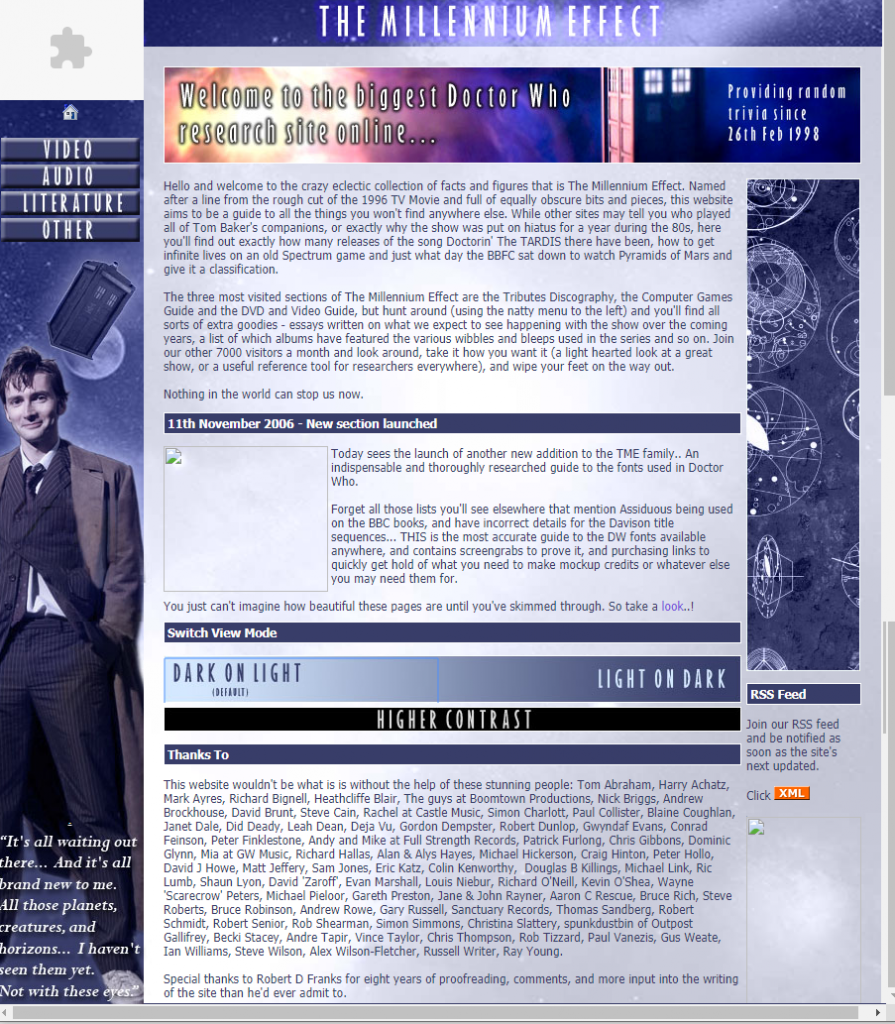
The homepage received minor tweaks over the next couple of years, including a mopey banner when Rose left the show in 2006:

In 2006, Torchwood began, and with that a new spinoff site was prepared and launched – www.torchwoodguide.co.uk. Torchwood Guide was regularly updated through 2006 and 2007, covering the first two seasons of the show.

By now, between TME, Return to Kendal and Torchwood Guide, the team were looking after three sites. It’s at this point that things exploded… A central website called The Whoniverse was launched, to form a wrapper around all three sites and provide site updates via an RSS feed. But plans were already afoot for a great many more sites…


2007 was when, to coin a phrase ‘everything changed’. In February TME received its final major update to the homepage layout until 2020, with a newly created image of Donna and the Doctor looking at a giant ‘welcome’ message.

Throughout 2007 and for several years beyond, the Whoniverse site was used a jump point for a huge number of websites the team hosted, and in many cases designed, alongside the continued focus on TME, Return to Kendal and Torchwood Guide:
Sarah Jane Guide (at sarahjaneguide.co.uk): A guide to The Sarah Jane Adventures, abandoned after the third season.
Lee’s Art (at whoniverse.co.uk/lee): A home for the fanmade artwork of the brilliant Lee Johnson, who later gained official commisions on a number of BBC products.
Nothing at the End of the Lane (nothing-lane.co.uk): The official homepage of the popular fanzine, covering its first two issues and first scriptbook.
Time Rotor (timerotor.com): A website that predated the Whoniverse, allowing fans to submit ideas for special features on DVDs, which was brought under the team’s banner.
Tapezinematrix (tapezinematrix.co.uk) and Sonic Waves (sonicwaves.co.uk): Two websites about fanmade tapezines – one more general and the other focussing specificaly on the popular series produced by Alan Hayes.
Dr Poo (drpoo.co.uk): A guide to the Australian radio spoof.
The Adventures of Sharon from Blackcastle (blackcastle.co.uk): Another site that predated the Whoniverse but was brought into the fold, producing humorous comics based on the Marvel Comics companion.
Jim Sangster’s Art (scouseanorak.co.uk): More fan art.
Doctor Who 2009 (doctorwho2009.co.uk): A planned series of fan productions throughout 2009, although in the event only one episode was ever completed. This wasn’t branded under the Whoniverse banner, but was designed by Matt and hosted by TME.
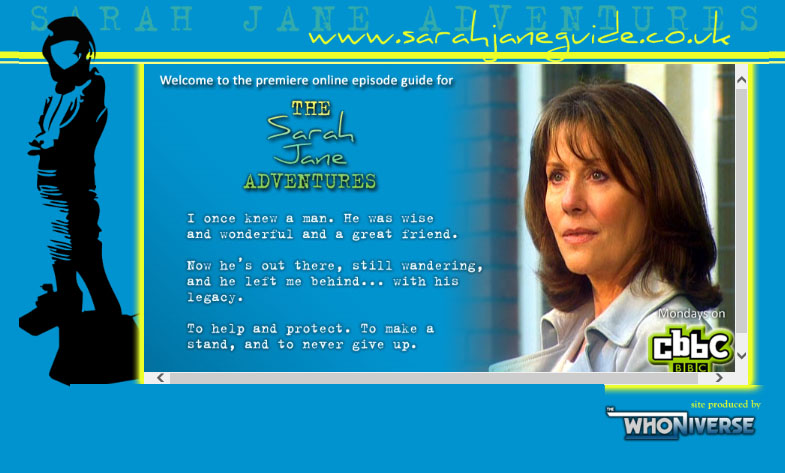
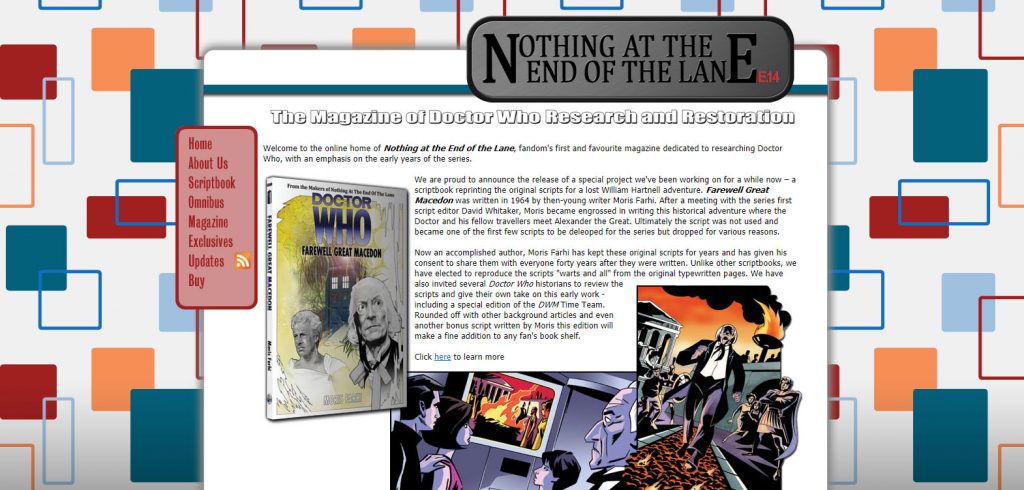
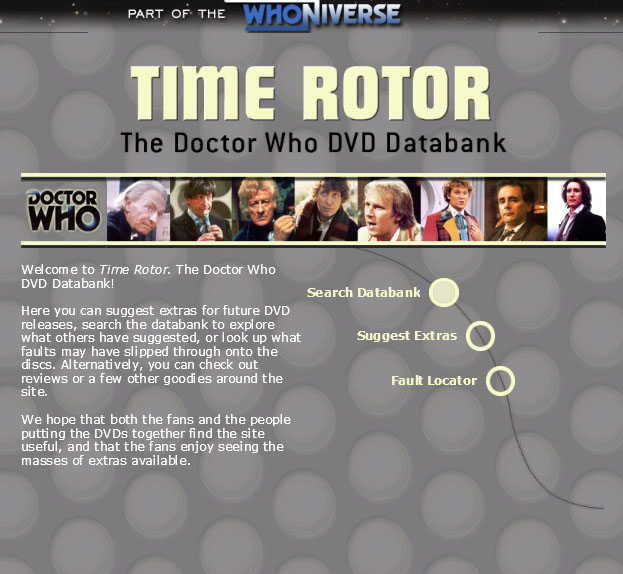
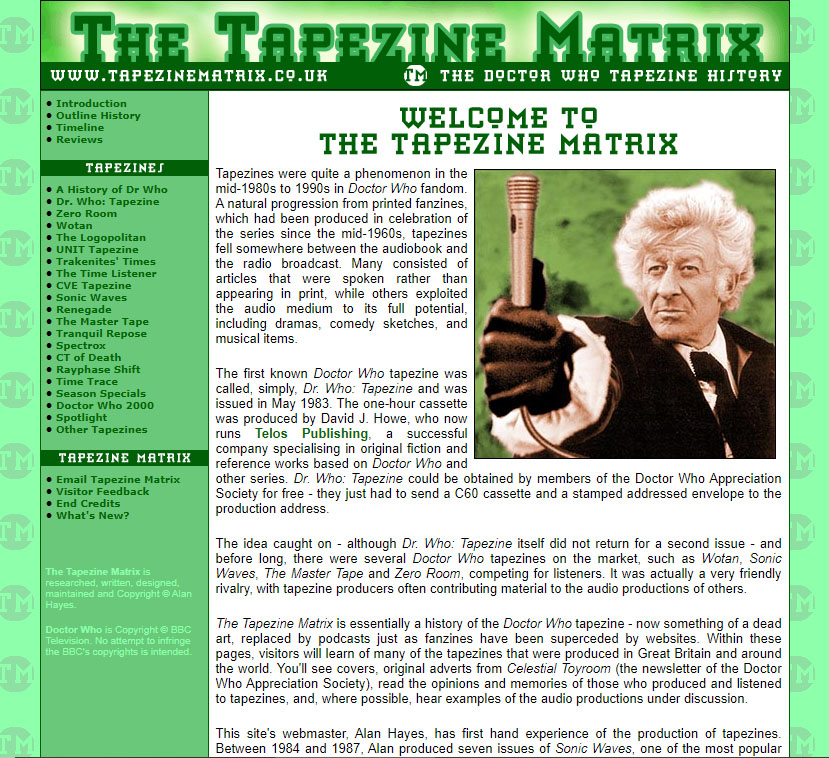
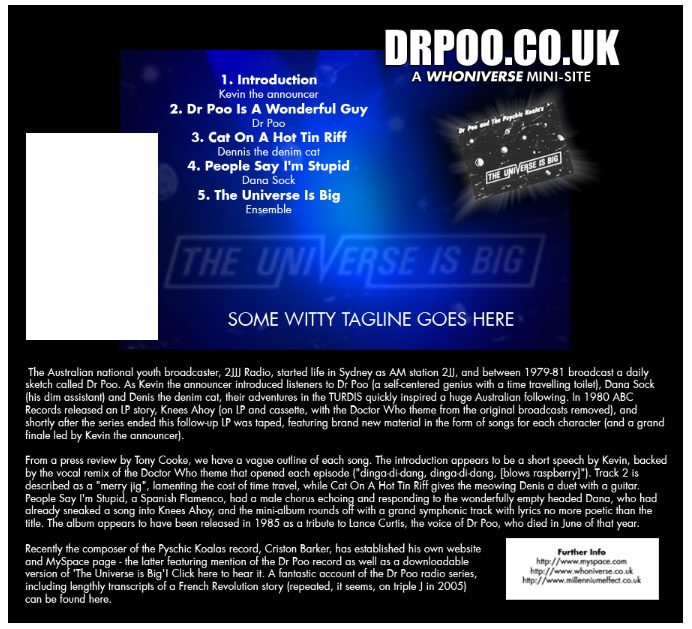
Early concept for drpoo.co.uk 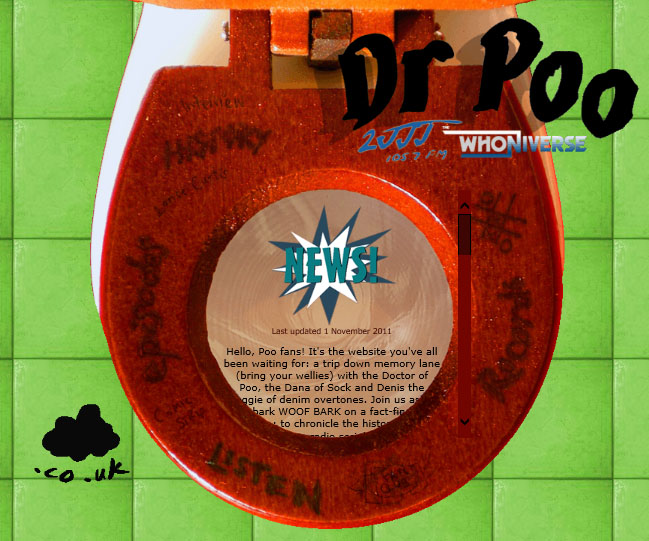
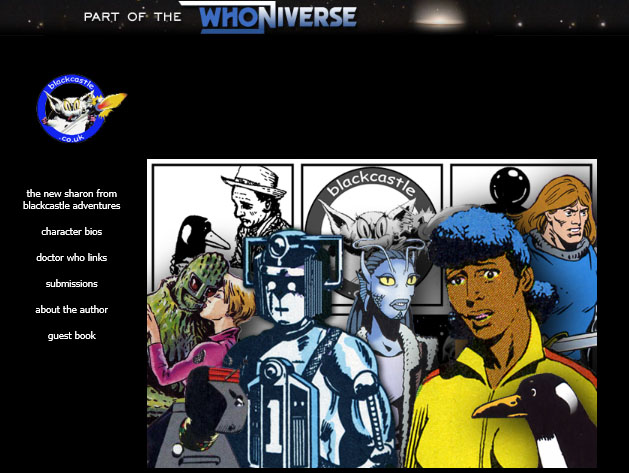
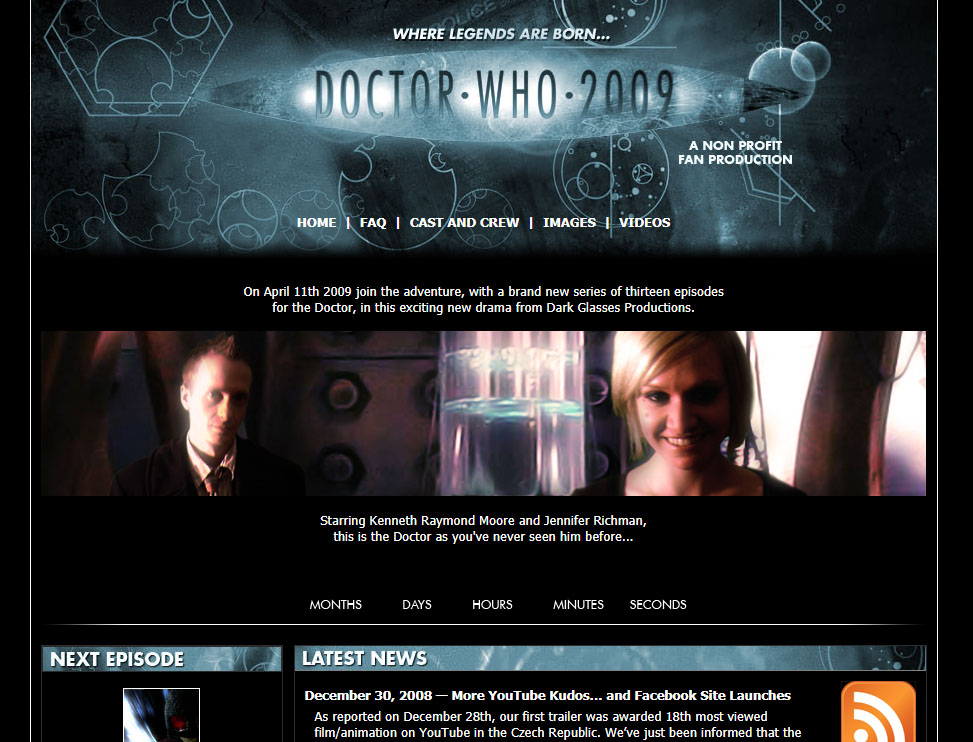
Under discussion but never launched was a shop, linked to an existing eBay store ran by a friend of TME, and a cafepress store selling books based on the TME pages, along with T-shirts and mugs containing humorous images vaguely related to Doctor Who. The team also planned a WAP site, back when WAP was a thing (it wasn’t a thing for very long- it was designed to allow phones to access very low quality versions of websites), which would have provided a simple episode guide to the show from 2005 onwards. The launch of 3G phones which larger screens made WAP largely redundant, and the content would hardly have been groundbreaking.
In 2008 Matt designed a new look, with some artwork provided by Lee Johnson, but the effort required to manually transfer all the content across, while still trying to maintain many other sites, prevented this from getting very far. The demo page below is all that exists.
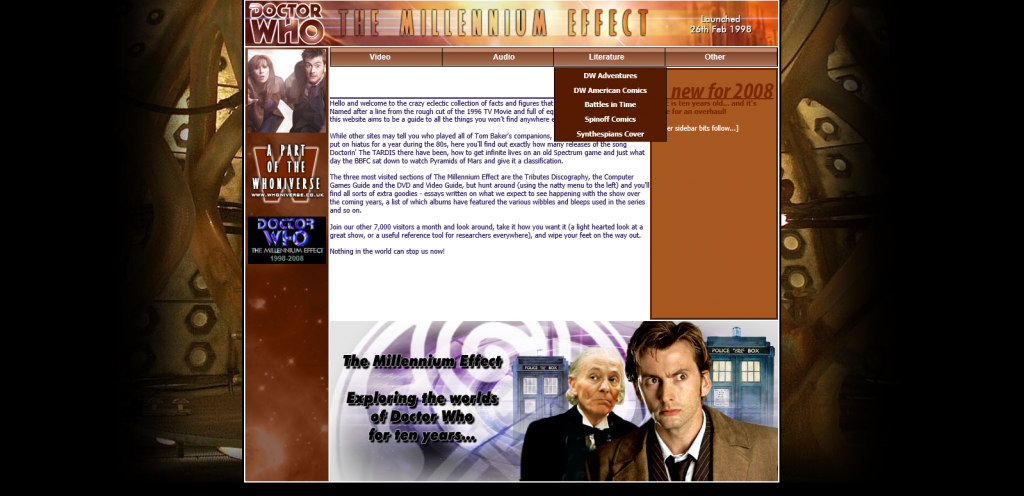
What next?
The Whoniverse sites all lasted for several years. The Sarah Jane and Torchwood sites ceased to be updated around 2010 but the URLs continued to be active until much later that decade. Lee and Jim’s art sites were both removed when they each became more involved directly with the BBC. The Time Rotor, Blackcastle and Doctor Who 2009 URLs were all owned by their creators and allowed to expire c2010. And Nothing at the End of the Lane splintered into two distinct groups – the original site remains to this day, hosted elsewhere, while a new site (www.endofthelane.co.uk) was launched by Richard Bignell, and although not under the Whoniverse banner itself, remains hosted by TME.
The Sonic Waves site was officially retired, but the parent Tapezine site still exists, now at a new location (tapezines.hiddentiger.co.uk) – still hosted by TME and now the only active site still containing a Whoniverse banner. Only the Dr Poo site, launched in 2011, received a high volume of updates throughout the decade.
TME also began hosting the official site of Graham Strong, a friend of one of the editors well known to fandom for recording early episodes on audio. With the TME and Whoniverse branding both declining, it was never suggested to bring gstrong.co.uk officially into the fold.
As for the Whoniverse itself: at its height it was an extremely popular jump point, and ran several competitions and features for the BBC and its licensees. But ultimately with the spinoff sites slowly expiring, the Whoniverse domain was allowed to quietly slip away midway through the 2010s.
During this time, Matt Smith and then Peter Capaldi replaced David Tennant as the Doctor. Without the time or interest in carrying out a full site redesign, Matt simply removed Tennant from the sidebar in around 2015, leaving a blue starscape in his wake.
And that brings us to 2020…
During the Coronavirus pandemic, when Matt had even less time to spare than normal (juggling work, childcare and a college course), he proposed a fresh new look using WordPress as a platform, finally replacing the thirteen-year-old design. This would enable a far more flexible and responsive design, and at last – after twenty years – the guys could leave their HTML coding behind and focus on some amazing content for the future. Even Clayton Hickman (DWM editor 2002-2007, and regular designer of early Big Finish CDs and Doctor Who DVDs) got in on the act, remastering the 1998 logo for its grand and long-overdue reapparance.
Here’s to another 22 years…

